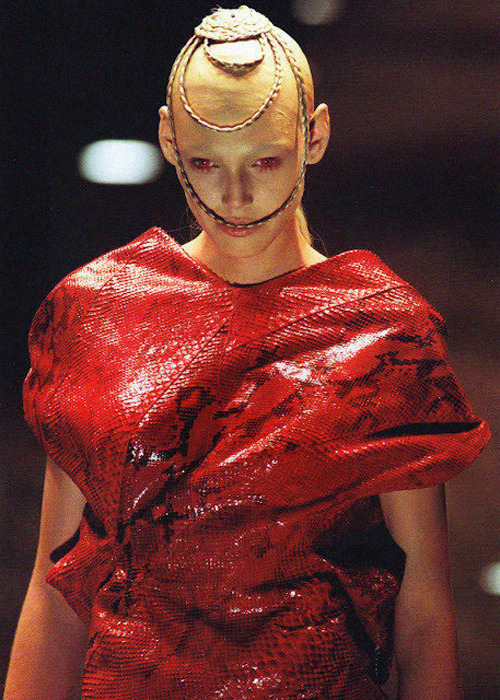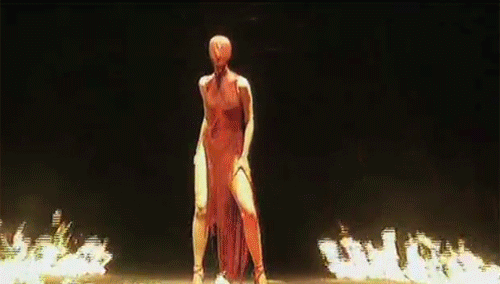In the world of fashion, it isn’t unusual for
designers to base an entire collection on one influential woman. It also isn’t
unusual for designers to source inspiration from history. However, it is more unusual
for a designer to manage to successfully tell a story with their collection but
with his A/W 1998 collection ‘Joan’ (see in full here), Alexander McQueen achieved just that. Speaking
in an interview, the designer explained “I don’t really get inspired by
specific women, it’s more in the minds of women in the past. People where were
doomed, Joan of Arc or Colette. Iconic women."
The make-up for the show itself was extremely
severe, and loosely based on McQueen’s own make-up for a photoshoot with Nick
Knight for the iconic ‘The Face’ magazine. Eyebrows were shaved, eyes were fitted
with blood-red contact lenses and heads were shaved and decorated with a
succession of intricate braids which wrapped around skulls and led into a
cascade of flowing blonde hair. The two opening looks matched the severity of
the make-up – both were engineered in chain mail and whilst the first was a
short look with a plunging backline, the second was a classic full-length gown
that elegantly swept along the sparse runway. The aggressive chain mail
material marked the beginning of Joan’s story, representing the armour that she
wore as a military leader.
The preceding looks all kept to the military
theme, essentially making up the first chapter of the story. Models strutted
down the runway in full-length tailcoats made from thick grey wool, each
adorned with several tiny black buttons that fastened all the way up into a
funnel neckline. More glamorous variations of the tailcoat were also shown –
one example featured religious iconography emblazoned onto a black background
illuminated with the glimmer of thousands of tiny sequins, whereas another was
realised in futuristic silver and once again imbued with shimmer thanks to the
metallic fabric. The colour palette for the opening section flitted between
sci-fi silver and dark burgundy – the mood of the collection was dark, gothic
and aggressive. Most of the looks were also heavily androgynous, a reference to
Joan of Arc’s choice to always wear masculine clothes – the heavy overcoats
were made to completely swathe her figure and act as a defence against
molestation.
By telling the story of Joan, McQueen
essentially chose to move away from his usual tactic of using exposed flesh to
provoke his audience. As opposed to many of his collections, the aim for this
collection was sensuality as opposed to sexuality – the eroticism came from the
way that the clothes clung to the body and subtle ruching was designed to
emphasise curves. Unlike in previous collections, the emphasis was on the suggestion
of sex as opposed to parts of the body being explicitly on show, and although
there were still a few sheer dresses on show (as well as a black mohair
turtleneck fitted with a sheer panel that exposed its wearer), the collection
showed a new side to McQueen and demonstrated that he didn’t have to rely on
nudity to shock or interest his viewer.
As the show progressed, the looks started to
become decidedly more delicate, a reference to Joan’s execution for which she
agreed to dress in a more feminine manner. The colour palette steered away from
burgundies and moved almost exclusively to black and red – the black meant to
symbolise death and the red meant to represent both the imminent danger as well
as the blaze of the flames that would soon kill the show’s heroine. Full-length
black coats were slashed at the sides to reveal shocks of crimson fabric
underneath, and the collection’s most famous look (worn by Lady Gaga at the
2009 VMAs) consisted of a short red gown complete with a red lace veil that
completely obscured the face. Glimpses of flesh came more frequently – the nudity
represented vulnerability, and it became evident that we were coming ever
closer to the show’s climax.
Finally, after 20 minutes of non-stop fashion, the lights began to dim and the music faded out completely. After a minute of darkness, a masked woman made her way into the centre of the runway and began to dance slowly as the show reached a fiery crescendo – a circle of flames engulfed the masked heroine as she posed defiantly amidst the flames. Arms raised, chest forward and legs open, the final blaze of glory depicted a woman that had remained strong right up until her execution – she was the quintessential McQueen woman, protected only by the armour of her clothing. This finale lasted long enough for the iconography to be firmly embedded in the viewer’s mind, proving that a McQueen show is never about trends. The designer himself has stated that the shows are always about providing ‘that one moment in time’ – it is a statement perfectly encapsulated by this incredible collection.
Finally, after 20 minutes of non-stop fashion, the lights began to dim and the music faded out completely. After a minute of darkness, a masked woman made her way into the centre of the runway and began to dance slowly as the show reached a fiery crescendo – a circle of flames engulfed the masked heroine as she posed defiantly amidst the flames. Arms raised, chest forward and legs open, the final blaze of glory depicted a woman that had remained strong right up until her execution – she was the quintessential McQueen woman, protected only by the armour of her clothing. This finale lasted long enough for the iconography to be firmly embedded in the viewer’s mind, proving that a McQueen show is never about trends. The designer himself has stated that the shows are always about providing ‘that one moment in time’ – it is a statement perfectly encapsulated by this incredible collection.





No comments:
Post a Comment